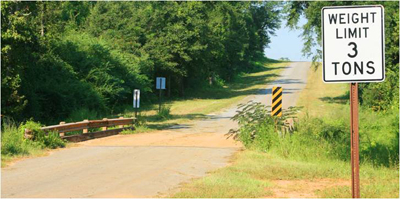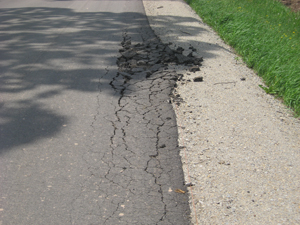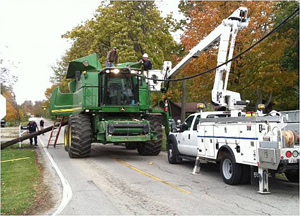Facts and studies |
Resources |
Task force |
Contact
Agricultural equipment is getting larger and heavier, which helps in more efficient farm production, but it can also impact pavement and road structures. That’s why WisDOT, in partnership with the Wisconsin Department of Agriculture, Trade and Consumer Protection, convened the Implements of Husbandry (IoH) Study Group. It involved over 20 stakeholders representing various transportation and farm organizations, equipment manufacturers, law enforcement, local officials and the University of Wisconsin-Madison/Extension.
Following months of research and discussion, the group presented preliminary recommendations at a series of town hall meetings. Feedback was also gathered through an online survey and letter and email submissions.
 After analyzing the responses, the IoH Study group amended its recommendations and submitted them to the Wisconsin State Legislature for their consideration. The study group’s final recommendations include:
After analyzing the responses, the IoH Study group amended its recommendations and submitted them to the Wisconsin State Legislature for their consideration. The study group’s final recommendations include:
- Create a clearer, simpler definition of IoH to reflect today’s agricultural equipment, which would also include a definition for commercial motor vehicles used exclusively for agricultural operations.
- Require all IoH that cross over the centerline of the roadway during operation to meet the lighting and marking standards of the American Society of Agricultural Engineers (ASAE S279).
- Create a 60-foot limit for a single IoH and a 100-foot limit for combinations of two IoH. For combinations of three IoH the limit is 70 feet, but a three IoH combination may operate at lengths exceeding 70 feet, to a limit of 100 feet, at a speed no greater than 20 miles per hour.
- Create a new IoH weight limit which is up to 15 percent weight allowance more than currently established by the federal bridge formula. This equates to a maximum single axle weight of 23,000 pounds and a maximum gross vehicle weight of 92,000 pounds except where posted and during periods of spring thaw.
- Require written authorization to exceed weight limits. On an annual basis IoH operators may submit a travel or route plan and request written authorization to exceed the weight limit from the maintaining authority of the roadways. A nominal fee may be charged and additional conditions may be set by each maintaining authority. IoH vehicles operating in excess of the 15 percent allowance will be fined for the amount in excess of standard gross motor vehicle weight or individual axle weight.
- Support exploration of best practices to assist in reducing the wear of roadways and structures. This includes the development of emerging innovations and best practices in manure management.
- Develop further training requirements for the operation of large IoH equipment. Age requirements are to remain as presently allowed in statute, but the group recommends developing advanced training for operating larger and heavier IoH.
The Study Group also sees the need to advance these issues to groups such as the Federal Highway Administration (FHWA) and the American Association of State Highway and Transportation Officials (AASHTO) to encourage the development of national standards. This approach will foster additional research where needed and encourage manufacturers to develop more road compatible equipment.
For a detailed list of the final recommendations please reference the IoH Group Phase II Addendum Report.
IoH facts and studies
Resources
IoH equipment matrix
Agricultural equipment and vehicles can cause damage on or along roadways
Large and heavy agricultural equipment and vehicles impact public roadways and structures. Town hall meetings are seeking feedback on recommendations to restore the balance between roads and agricultural equipment.

Posted weight limits for culvert crossing

Broken pavement

Damaged power lines
IoH task force
In an effort to clarify statutory distinctions among agricultural equipment types, an IoH task force was created in the Fall of 2012 to examine and analyze current IoH. The IoH Study Group is comprised of:
- Wisconsin Department of Transportation
- Wisconsin Department of Agriculture, Trade, and Consumer Protection
- UW Center for Agricultural Safety and Health
- UW-Madison Department of Biological Systems Engineering
- UW-Extension Environmental Resource Center Wisconsin Traffic Operations and Safety Laboratory
- Private Industry:
- Professional Nutrient Applicators Association of Wisconsin
- Wisconsin Farm Bureau Federation
- Professional Dairy Producers of Wisconsin
- Wisconsin Towns Association
- Wisconsin County Highway Association
- Maxville Truck and Repair
- Wisconsin Custom Operators
- League of Wisconsin Municipalities
- Wisconsin Agri-Business Association
- Husky Farm Equipment (Ontario, Canada)
- Association of Equipment Manufacturers (Milwaukee, Wisconsin)
- Dairy Business Association
- Wisconsin Independent Business
- RCI Engineering LLC
- Equipment Manufacturers:
- John Deere
- Kubota Tractor Corporation
- Case New Holland (CNH)
- AGCO
Contact:
Questions and comments about the study and/or the report, contact
IoHStudyFeedback@dot.wi.gov.